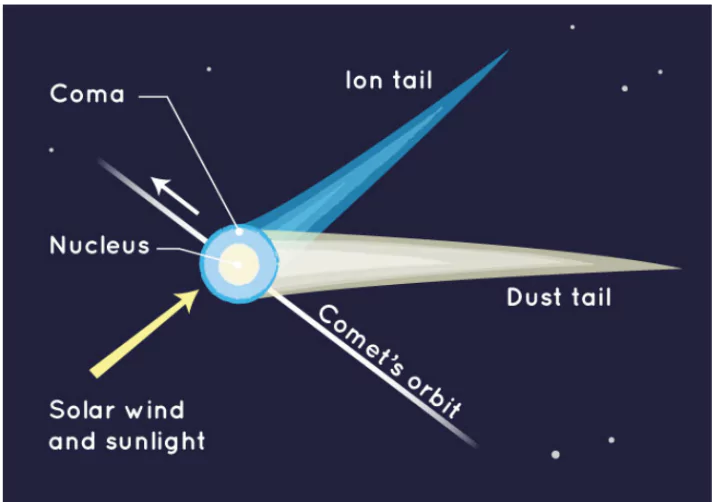Ten new dark comets were discovered recently by the Dark Energy Camera (DECam) instrument placed on a large telescope in Chile.
About Dark Comets

- A Dark Comet is a celestial object that looks like an asteroid (devoid of the bright coma characteristic of traditional comet) but moves through space like a comet(such as sudden accelerations)
- First Discovery: The first dark comet, identified in 2016, was asteroid 2003 RM and was nicknamed “The Asteroid that Wanted to be a Comet.”
- NASA in 2017 discovered (‘Oumuamua’), the first ever documented celestial object that originated outside the solar system which appeared like an asteroid but behaved like a comet.
- Categories: There are 2 main categories of Dark Comets,
- Inner Dark Comets: They reside in the inner solar system and travel in nearly circular orbits, and are on the smaller side (tens of meters or less).
- Outer Dark Comets: They have similar characteristics to Jupiter-family comets ie. They have highly eccentric (or elliptical) orbits and are on the larger side (100m or more).
- Characteristics:
- Elusive: Dark comets lacks the characteristic feature of a comet ie. a glowing tails and instead appear as a faint point of light in space resembling an asteroid.
- Orbit: Dark comets follow elongated, elliptical paths and can go beyond Pluto, some even making it out to the Oort Cloud,
- Size: Dark comets are often small objects, just a few metres to a few hundred metres wide leaving less surface area for material to escape and form into the beautiful tails as seen on typical comets.
- Spin: They often spin quite rapidly and disperse escaping gas and dust in all directions, making them less visible.
- Composition or Age: Their composition and age may result in weaker or no gas loss, as the materials that go into the tails of bright comets are depleted over time.
- Significance:
- Planet Formation: Studying Dark Comets assumes significance as it could hold clues about the formation of Earth, the origins of Earth’s water, and even the beginning of life
- Abundance: A 2023 study suggested that between 0.5% and 60% of all NEO might be dark comets originating from the asteroid belt between Mars and Jupiter.
Check Out UPSC Modules From PW Store
Asteroid
- An asteroid is a small, rocky object which appears as a point of light in space.
- Found: Most asteroids are found in a ring between the orbit of Mars and Jupiter called the asteroid belt.
- Composition: They are mostly made up of metals and rocky material.
- Size: Asteroids varies in size and shape with some asteroids being round, some are elongated, and some even having a satellite.
- Asteroids formed much closer to the Sun, where it was too warm for ices to remain solid.
Comet

- Comets are basically dusty snowballs which orbit the Sun.
- Composition: They are made of ices, such as water, carbon dioxide, ammonia and methane, mixed with dust
- They are formed farther from the Sun where ices would not melt.
- Parts:
- Nucleus: It is the icy centre part of the comet and is less than about 6 miles (10 km) wide.
- Coma: It is a large cloud of gas and dust surrounding the nucleus. It is created as the ice in the nucleus is warmed by the Sun and vaporizes
- The size of coma can expand out to 50,000 miles (80,000 km)and more as they come close to sun
- Tails: Comets can develop two tails as they travel closer to the Sun. Comet tails can be over 600,000 miles (1 million km) long.
- Straight Gas Tail: The gas tail is created by the solar wind, pushing gas away from the comet’s coma and pointing straight back from the Sun.
- Curved Dust Tail: The dust in the coma is vaporized by the Sun’s heat, and forms a curved tail which follows the comet’s orbit.
|
![]() 20 Dec 2024
20 Dec 2024

